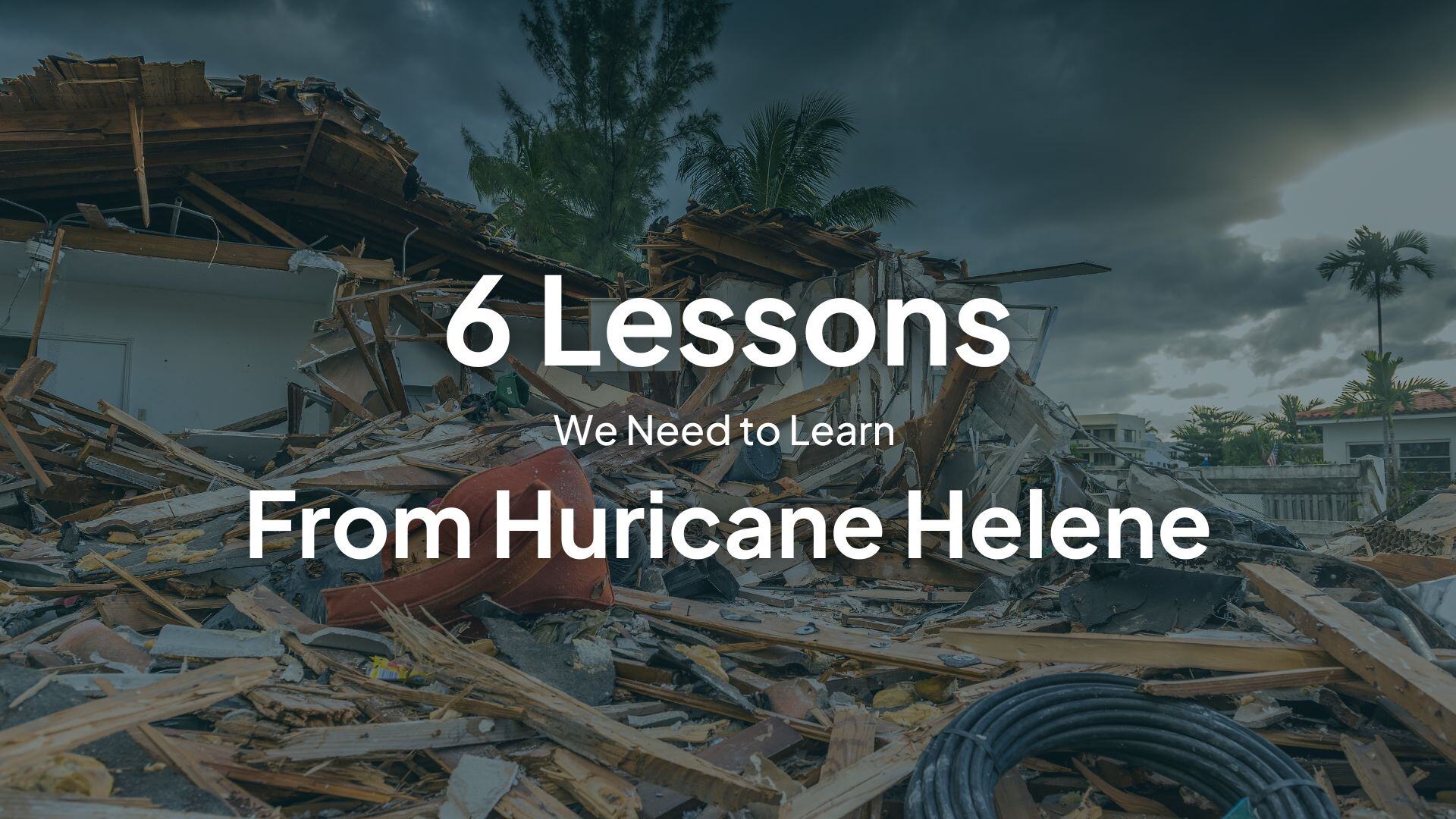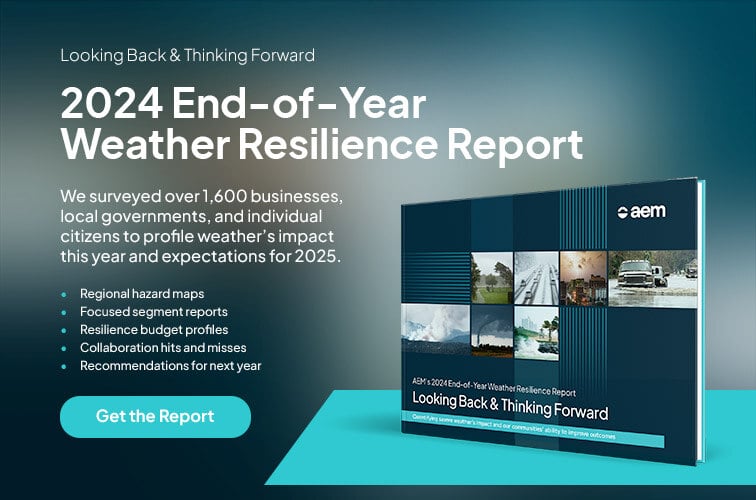
Hurricane Helene will be remembered as one of the most devastating natural disasters in recent history. With its extreme winds, torrential rains, and deadly storm surge, it left behind a trail of destruction that spanned hundreds of miles and claimed hundreds of lives. But if we allow ourselves to look beyond the immediate toll, the storm’s impact serves as a stark reminder of the growing risks we face from extreme weather. As the frequency and intensity of extreme weather increase, so too must our ability to adapt, recover, and fortify our communities against future threats.
In this post, we’ll explore the facts behind Hurricane Helene and reflect on six crucial lessons we can draw from this catastrophic event—from the intensifying nature of storms to the vulnerabilities in our infrastructure and insurance systems. By embracing these lessons, we can better prepare for a future where extreme weather is becoming the new normal—and ensure that our communities are equipped to withstand the storms ahead.
Hurricane Helene by the numbers
Hurricane Helene was a stark reminder of nature’s unpredictability and power. As a Category 4 hurricane, Helene unleashed devastating winds, record-breaking storm surges, and catastrophic flooding across the southeastern U.S. The storm's toll extended well beyond property damage, with hundreds of lives lost and entire communities left in ruins. In this section, we’ll break down the key facts about Helene’s landfall, the scale of its destruction, and the economic and human costs that have made it one of the deadliest and most expensive storms in U.S. history.

- One storm, multiple hazards: Making landfall as a major Category 4 hurricane, Helene produced extreme winds of 140 miles per hour, record storm surge, severe rain, and tornadoes. As it worked its way inland, the storm left behind a 500-mile path of destruction. This video from Keaton Beach, Florida shows the impact of Helen’s storm surge and high winds:
Hurricane Helene left behind a trail of destruction from storm surge and powerful winds in Keaton Beach, Florida. pic.twitter.com/xh3V4ueEc8
— AccuWeather (@accuweather) September 29, 2024
- Extreme rain and flooding: The rain from Hurricane Helene was especially noteworthy. It dumped 42 trillion gallons of rain. For perspective, Lake Tahoe only has about 37 trillion gallons of water. This post from X shows the shocking speed at which some of the flood waters traveled.
This is unreal video sent from a friend who is alive and okay outside of Boone #hurricanehelene #westernnc #wnc pic.twitter.com/XUsqcI3zNJ
— Greg Biffle (@gbiffle) September 30, 2024
- Costly impact: Total damage and economic losses from the storm are now estimated to range from $225 billion to $250 billion. This would make it the costliest natural disaster in U.S. history (so far). This post provides a taste of the destruction caused by the storm.
My friend went to Chimney Rock to help with the ground effort recovery. He just sent me videos. The town is gone. And this is what it looks like across dozens of mountain communities.
— Ella Dorsey (@Ella__Dorsey) October 2, 2024
Helene is officially the 2nd deadliest hurricane in the last 50 years. pic.twitter.com/98qqeXoSCh
- Deadly consequences: As of this writing, the death toll from Helene has climbed well above 200, making it the deadliest hurricane since Katrina in 2005. And with hundreds more still missing, the final tally could be significantly greater. About half the fatalities, so far, have been in North Carolina.
6 lessons from Hurricane Helene
While we cannot control the weather, we can learn how to better prepare, adapt, and build resilience in the face of rising climate risks. In this section, we’ll explore six critical lessons from Helene’s devastation—lessons about the growing intensity of storms, the need for more robust infrastructure, and the importance of rethinking how we protect our homes and communities from future disasters.
Lesson 1: Extreme storms are becoming more common and more extreme.
Shortly before making landfall, Hurricane Helene rapidly intensified into a major Category 3 storm, then into an even stronger Category 4 storm. Scientists have noted that this pattern of rapid intensification seems to be becoming more commonplace with hurricanes. Although the number of hurricanes is not necessarily increasing, a larger portion of them is turning into major storms (Category 3 and above).
As the climate warms, the atmosphere can hold more moisture. So, when it does rain, there may be more of it. As a consequence, extreme storms are becoming both more frequent and more intense. Today, extreme rainstorms are 1.3 times more frequent than they were in the 1850s. By 2030, they could be 1.5 times more frequent.
To take just one additional example, a few days before Hurricane Helene swept through the southeast, an unnamed tropical storm blew through North Carolina. Although it didn't get national media attention, it dumped 12-20 inches of rain over 12 hours across a 25-mile-wide region of southeast North Carolina. It was classified as a "once-in-a thousand-years-storm"; yet, it was the fifth such storm that the area had seen in just the past 25 years.
Lesson 2: Extreme flooding is also becoming more common.
While there isn’t a perfect correlation between increased rainfall and increased flooding, experts believe that extreme flood events will increase in frequency and intensity as the Earth’s temperature continues to warm. It’s the moderate flood events, which communities tend to be better prepared for, that are more likely to decline in frequency.
Lesson 3: Our flood and water infrastructure is not up to the task of handling the extra risk.
Thankfully, there were no catastrophic dam failures during Hurricane Helene, but there were several evacuations due to fears of impending failure and water overflowing dams.
Much of the flood and water infrastructure throughout the United States is nearing (or has already extended beyond) its designed lifespan. An AEM survey of public works professionals revealed that, on average, the age of water infrastructure was 7 years beyond its designated lifespan (56 years vs. 49 years).

This presents a two-fold problem. Infrastructure that has aged beyond its designed lifespan it going to be inherently more vulnerable to failure than infrastructure that has not. Secondly, our outdated infrastructure was designed for the flood and rain risks we were facing 50+ years ago—not for the heightened risks we face today.
Lesson 4: These problems are being exacerbated as people increasingly move into high-risk areas.
Many of Helene’s victims were in floodplains. Increasingly, human populations across the world are moving into flood-prone areas, such as low-lying coastal areas, river valleys, and downstream from dams.
But, the migratory problem extends beyond hurricane and flood risks. A recent analysis by the New York Times showed that, over the past two decades, people have predominantly been moving into U.S. counties that face heightened risks for hurricanes, major wildfires, floods, and extreme heat. When disasters do strike, these trends mean that more people are more likely to be impacted.
Lesson 5: There is no place to escape growing climate risks.
The counterpoint to lesson four is our fifth lesson. Even if we were highly selective about where we build, there would still be no escaping growing climate risks.
Some communities have billed themselves as "climate havens," refuges from the effects of climate change. Ironically, Asheville, North Carolina, which is perched far from the coastline and high in the Blue Ridge Mountains, was billed as one such community. Yet, it was one of the hardest hit areas. So far, more than 40 people have died in Buncombe County where Asheville is located.
With the city’s high elevation and distance from the coastline in western North Carolina, it’s easy to understand why residents would think they would be relatively insulated against hurricane-related risks. No one would have expected a hurricane to carry as much rain as far inland as Helene did. Yet, that’s exactly what happened.
Lesson 6: Our homes and infrastructure are not adequately insured against flood risks.
According to current estimates, total economic losses from Hurricane Helene could be as high as $160 billion. But, the estimates for total INSURED losses are only $10.5-$17.5 billion. That's because most homeowner insurance covers wind and rain damage, but not flood damage. In fact, in the hardest hit parts of North Carolina, like Buncombe County, less than 1% of homeowners have flood insurance.
To understand why so few affected homeowners had flood insurance, we need to look at how the National Flood Insurance Program (NFIP) works. Anyone who uses a federally backed mortgage to purchase a property with at least a 1% chance of flooding each year is required to purchase flood insurance. The system is based on FEMA flood maps that indicate where the high-risk properties are located.
The problem is that as more extreme floods become more frequent, FEMA’s flood maps are becoming outdated faster than new ones can be produced. What’s more, the maps focus on river and coastal flooding and fail to account for flooding caused by extreme rainfall (which is itself becoming increasingly common). As a result of problems like these, a 2017 study by Homeland Security concluded that 58% of all FEMA flood maps were considered inaccurate or out of date.
What does this mean for communities and homeowners that rely on FEMA flood maps? According to 2020 modeling by First Street Foundation, of the 14.6 million properties that may be at high risk of flooding, fewer than 60% are designated as high risk by FEMA flood maps. This aligns with FEMA’s acknowledgment that more than 40% of claims through the NFIP come from outside of designated high-risk areas.
Turning lessons into action
Hurricane Helene may have passed, but its impact and its lessons will resonate for years to come. As extreme weather events become more frequent and more intense, we can no longer afford to take a purely reactive approach. Whether it's updating our infrastructure, improving our flood preparedness, or rethinking how we build in high-risk areas, the time to act is now. By learning from Helene, we can help our communities build the resilience they need to weather growing climate risks and future storms.
It’s up to each of us—citizens, policymakers, and business leaders alike—to push for smarter climate policies, stronger infrastructure, and better preparedness. The next storm may come sooner than we think, and what we do now could mean the difference between devastation and survival. Let’s take these lessons to heart and act before it’s too late.

